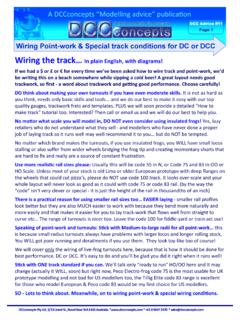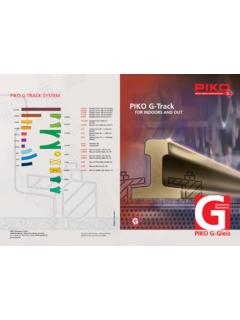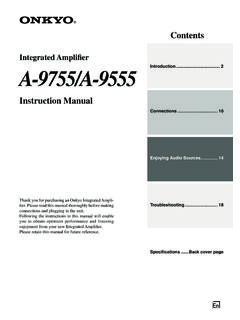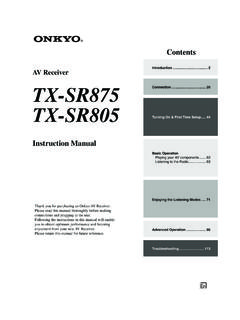Transcription of MANUAL FOR DCC TURNTABLE Contents - Gaugemaster.com
1 DCC / ANALOG TURNTABLE 84089121 Page 1 MANUAL FOR DCC TURNTABLE Contents : Page: Introduction 2 Before you get started 2 Adjustment of tracks 2-3 Connection Wiring diagram 3-4 Functions and overview of the Control Box 4-6 How to program your TURNTABLE 6 o Performing a reset / Menu point 7 o Calibrating the bridge / Menu point 7 o Setting a programmed stop of the bridge / Menu point 7-8 o Deleting a programmed stop of the bridge / Menu point 8-9 Driving the bridge to a programmed stop / Menu point 9 Maintenance 9-10 FAQ 10-11 DCC Uhlenbrock / Lenz / Esu 11 o Setting the TURNTABLE s digital address 11-12 Technical Specifications 12 Please read the
2 MANUAL carefully before installation and operation. DCC / ANALOG TURNTABLE 84089121 Page 2 1. Introduction Dear Customer! Thank you for purchasing the HELJAN DCC / Analog TURNTABLE . your new HELJAN TURNTABLE has many features; therefore it is important to carefully read this guide before installing it on your layout. The TURNTABLE is like a small computer, working on very small voltage / impulses, therefore it is important always to keep the moving components (gears, optical eye etc.) very clean. HELJAN has produced a TURNTABLE that meets all the requirements needed for a modern DCC layout.
3 If installed and used correctly, this product will give years of service! 2. Before you get started your TURNTABLE should be powered from its own transformer (not included). Check the output of the transformer is correct for this use before making any electrical connections. The ideal voltage to operate the TURNTABLE is 15v AC, 500 mA. The opening in the wall of the pit houses the optical sensor and is used as the ``zero point . For the indexing to work properly, this area and the small gear teeth and ring rail moulded in the bottom of the pit, must be clean and open at all times. If you wish to paint or weather the pit further, mask off these areas before starting.
4 Please note that it s not possible to make a position directly at the ``zero point . Before installing the pit, cover the centre pivot hole with tape to keep out dust and debris. your new TURNTABLE must be installed on a flat, stable and level surface. Determine the location for your pit and use the enclosed template to cut the mounting hole in your baseboard. Allow at least 2 ( cm) of clearance below the pit. The zero reader is mounted directly below a mounting boss; be sure to provide clearance in your baseboard for the reader too. Pre-drill the positions for the mountings as shown on the template with an 8 mm bit. Secure the pit in place using eight screws and washers (not included) - do not over tighten as this could cause the pit to warp.
5 If you are using foam / polystyrene for the surface of your layout, open the areas for the mounting bosses slightly and push the pit into place. Make sure the pit is level, secure and properly supported before proceeding. When you have removed the bridge from the pit, it s important that the power is switched off. 3. Adjustment of tracks With the pit in place, you can install the approach/exit tracks. The indexing can be programmed for up to 48 different stopping positions, so you can add tracks almost anywhere around the pit but remember, don t install tracks in the ``NO TRACK areas. a) b) DCC / ANALOG TURNTABLE 84089121 Page 3 with a file Wire diagram for DCC: The bridge is equipped with a Code 83 rail-profile; if you are using another profile for your track, use of transition tracks may be necessary.
6 The top of your rails and the bridge rails must be level. For a smooth transition between the bridge and service tracks, you need to modify your rails by filing the inside at a slight angle for about 3/16 (4 mm) (see Fig. 1). For the rails to sit correctly on the lip of the pit, you must remove a few sleepers from the end of the track. Important note: Leave a gap of about 1/16 ( mm) between the end of each service track and the bridge. All service tracks must align with the bridge rails in a straight line. The bridge can be used as a guide. Wire the service tracks (parts not included) for power as desired. You must fix the position of your service tracks, before you program the positions.
7 4. Connection Wiring-diagram Please note that your DCC TURNTABLE automatically reverses the track polarity in the No Track area. It is therefore important that you are aware of the polarity over and under the No Track area. Wire diagram for Analog: a) DCC / ANALOG TURNTABLE 84089121 Page 4 All red wires should be connected. All blue wires should be connected. If a short circuit occurs when the loco is running onto the bridge, the wires in screw terminal 1 and 2 should be reversed. Finish by vacuuming and cleaning your TURNTABLE . Clean the contacts in the pit and on under the bridge. See Fig.
8 4 Contact under bridge: Clean in Propyl Alcohol or similar and finish by wiping with a dry cloth. Contacts in Pit: Clean in Propyl Alcohol or similar. Use a cotton bud and be careful, not to bend the contacts, because this may affect the contact to the bridge. It is important that the power is switched off when you clean the contacts 5. Functions and overview of the Control Box Operational overview The electronic control integrated into the Control Box for the TURNTABLE has the following characteristics: Analogue and digital operation The TURNTABLE can be used on analogue model railway layouts as well as digital model railway layouts run in DCC format.
9 In analogue operation the TURNTABLE is run via the control box. In digital operation it is possible to remote-control the TURNTABLE from a digital control unit via the Control Box. The electronic control automatically recognizes the operational mode (analogue or digital) and the digital format DCC that is run. Settings The electronic control allows you to define up to 48 individual stops of the bridge. Please note: Stops can be added or deleted separately at any time. Also please note, that when a position/stop is set, a 180 degree position/stop, from current position, is automatically set. Running The motor running the bridge is driven with a starting and braking delay that replicates the operational characteristics of the prototype.
10 B) c) Contacts un der bridg eContacts in Pit a) DCC / ANALOG TURNTABLE 84089121 Page 5 Connecting power supply and TURNTABLE TURNTABLE Connect the TURNTABLE to the Control Box the cable which is supplied. Power supply Connect the control box either to the booster of your digital layout or to the AC power supply of your analogue layout (not exceeding 18vAC). Do not mix up the connections! See Fig. 2+3 on page 4 Display and function keys of the Control Box Display The digital display has 4 digits. During operation and while making settings, all relevant information is shown here.
















